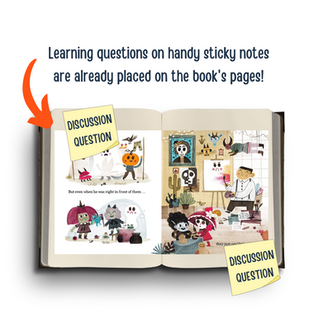
ABOUT THE STORY
Gustavo is a shy ghost with a talent for the violin. In this beautiful book, both written and illustrated by Mexican creative Flavia Drago, we get an inside peek into Gustavo’s identity, from his family home to his personal gifts. We also see visual references to Mexican cultural traditions connected to El Día de Los Muertos in each scene. In the end, when Gustavo invites his friends to share his musical gift, will they show up?
This book can be used to seed conversations about fall celebrations, feelings, friendship, and the difference between cultural appropriation and cultural appreciation as well.
LEARNING THEMES
IDENTITY, BELONGING, DIVERSITY, GHOSTS, FRIENDSHIP, EL DÍA DE LOS MUERTOS, APPRECIATION V. APPROPRIATION
ABOUT THE CURRICULUM
Our curriculum and ongoing practices are rooted in emergent strategy: “the way complex systems and patterns arise out of a multiplicity of relatively simple interactions.” The interactions we have with books, among reading partners, inside classrooms, and within reading communities are relatively simple. What is cultivated from those interactions is something much more complex – lifelong, daily abolitionist, decolonizing, heart/body-centered, and anti-racist practices. These include learning how to make the ground more fertile for ongoing identity, healing, discussion, action, and imagination practices in ourselves and with each other.
This reading guide was written by Zapoura Newton-Calvert and was designed to accompany David Robertson and Julie Flett’s picture bookWhen We Were Alone. Reading Is Resistance sees reading as an opportunity to seed deeper learning, conversation, and possibilities for action around racial justice and liberation in our communities.
PREVIEW
PURCHASE NOW
THE CURRICULUM KIT: we'll send you the book, sticky note conversation starters, and our social justice curriculum
THE DIGITAL DOWNLOAD: download the social justice curriculum now















Comments